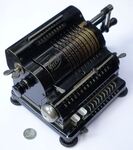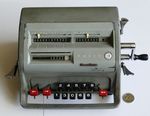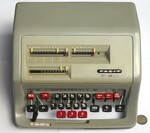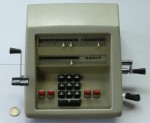



The Facit Standard is a pinwheel calculator, with an advanced design that has many clever innovations that put it ahead of its contemporaries.
The back plate has the serial number 7868, and according to Rechenautomat.de this was made in 1928.
There is a long worm gear in the back of the machine that drives the movement of the carriage. The mechanism for incrementing the counter is shifted along the counter register digits by the screw of the worm gear, while the carriage is shifted in the opposite direction through the large intermediate gearwheel.
The model C1-13 is mechanically very similar to their first Model T 10-key calculator from 1932, but with a more modern exterior design by Sigvard Bernadotte.
The main register at the top left has 13 digits, the revolution counter at the top right has 8 digits, and the input register at the bottom left has 9 digits. Each of these is cleared by one of the three levers on the side of the machine. It has a number of clever innovations that set it apart from other pinwheel calculators:
The engraved plate on the bottom of the machine bears the serial number 556,853. The first C1-13 had serial number 550,001 and was made in 1957, and my machine must have been made later in that year. It still has a round Åtvidaberg button on the front and on the back separated letters spelling out FACIT. It also has a logo from Blikman & Sartorius, who were a Dutch office supplies company who were the main Facit importer in the Netherlands. From 1957 to 1969, about 20,000-30,000 were made every year, for a total of about 315,000.
The casing can easily be removed. First unscrew two of the small levers. The casing is held in place by metal clips that hook into the holes for the two removed levers. Simply push in the clips and the casing comes free.
There are two further noteworthy innovations:
The serial number that is engraved on the internal frame is 241,517.
The model CA1-13 is an electric fully automatic calculator. It is similar in design to the C1-13, and its three visible registers have the same capacity. It also has an internal register that stores one of the factors when using automatic multiplication.
In most general use, the lever at the front left is in its leftmost position. In this mode, the buttons have the following functions:
To do automatic multiplication, simply enter the first number, press ×, enter the second number, and finally press =. To reuse the first number in another multiplication, use the × button to clear the input before entering the new second factor and pressing =. The calculation uses shortcut multiplication wherever possible for any digits of 6 or higher in the internal register.
If the main lever is in the middle position, the input will no longer be
automatically shifted left when you release the + or ÷ button. Instead
the input either does not move at all or it shifts right, depending on the
small lever to the right of the main lever.
If the main lever is in the right position, then the calculator is in
division mode. Some keys change their function in this mode:
A division can be performed as follows:
To enter the dividend in the main register, input a number, press ↤ and then press ADD.
To enter the divisor, input a number and press ↤.
To start the division, press ÷.
The engraved plate on the bottom of the machine bears the model designation and the serial number 723,183. That means it was made in 1961. From 1956 to 1973 almost 300,000 were made.
The model CM2-16 is a manual calculator, mechanically somewhat similar to the C1-13, but with a number of interesting changes:
The engraved plate on the bottom of the machine bears the model designation and the serial number 1,405,573. That means it was made in 1966. From 1959 to 1967 about 129,800 were made, followed by about 25,200 of the mechanically identical Facit 1004. The serial number that is engraved on the internal frame is 846,567.
On the older Facit machines the input setting wheels had zero in the middle, with 1-4 on one side and 5-9 to the other. This meant that a key press would only need to turn the input wheel at most 5 steps. This arrangement could not eaily be made to work with a back transfer mechanism, so on the CM2-16 the input wheels have 0 to 9 in order, so pressing the 9 key has to rotate an input disc a whole 9 steps. They managed to make the input wheels so light and easy to move that there is barely any noticable difference between pressing 1 and pressing 9.
Facit AB was a Swedish company founded in Stockholm in 1918 that made mechanical calculators. The calculators were designed by Karl Viktor Rudin, based on the classic Odhner pinwheel design. In 1922 Facit AB was bought by AB Åtvidabergs Industrier, a company based in the municipality Åtvidaberg which made office furniture and supplies. They made various high quality pinwheel calculators until in 1932 they made their first 10-key calculator, again designed by Rudin. It was named the Facit model T and became very successful. It was so successful that they continued to make variations of this design, including electrically driven versions, for the next four decades.
In the late 1960s they made a deal with the Japanese company Sharp to make desk calculators using Sharp's electronics. However, in the early 1970s the appearance of handheld electronic calculators made mechanical calculators obsolete, and Facit AB was unable to change quickly enough, and was bought in 1973 by Elektrolux.
Here is a quick overview of most of the models that Facit made. The information is taken from the serial number data found on the Rechenautomat.de website. There you can also find the exact year for each serial number. Note that a number of Facit machines were produced in Germany, and those have separate serial numbers and are not included in the counts below.
| Standard pinwheel models | |||
|---|---|---|---|
| Model | Year | Number made | Remarks |
| Original | 1918-1924 | 1910 | 9×10×15, stationary counter register in body |
| Standard | 1924-1927 | 5212 | 9×10×15 |
| Standard&Facit 10 | 1928-1931 | 5439 | 9×10×15 |
| Facit S | 1935-1954 | 40444 (?) | 8×10×13 (The serial number data for 1947 is suspect, and may be about 25000 too high) |
| 10-key models (Dalton keyboard), 9×8×13 | |||
| Model | Year | Number made | Remarks |
| Facit T | 1932-1939 | 10800 | left shift for division at most 7 places due to rev counter size. |
| Facit TK | 1936-1954 | 139500 | DE719718, left shift for division goes all way |
| Facit NTK | 1954-1957 | 54700 | New case, better sound insulation. |
| Facit C1-13 | 1957-1969 | 315000 | Bernadotte case |
| Facit E | 1934-1939 | 3500 | Electric version of T |
| Facit EK | 1936-1943 | 14850 | Electric version of TK |
| Facit NEK | 1943-1948 | 9200 | |
| Facit NE | 1953-1956 | 6900 | As NEK, for export |
| Facit CE1-13 | 1956-1960 | 4500 | Bernadotte case, for export |
| Facit EA | 1939-1943 | 4450 | Electric, semi-automatic |
| Facit NEA | 1943-1956 | 106242 | |
| Facit CS1-13 | 1956-1965 | 91162 | New case, better sound insulation |
| Facit ESA | 1945-1950 | 15150 | Electric, Fully automatic |
| Facit ESA-0 | 1949-1956 | 53550 | ESA with electric clearing |
| Facit CA1-13 | 1956-1973 | 296348 | Bernadotte case |
| 10-key models (Dalton keyboard), 9×10×19, Moving carriage | |||
| Model | Year | Number made | Remarks |
| Facit LX | 1938-1954 | 11450 | |
| Facit NLX | 1954-1956 | 2360 | New case, better sound insulation |
| Facit C1-19 | 1956-1960 | 6394 | Bernadotte case |
| 10-key models (Number pad), With transfer mechanism | |||
| Model | Year | Number made | Remarks |
| Facit CM2-16 | 1959-1967 | 129800 | |
| Facit 1004 | 1967-1969 | 25218 | |
| Facit CM2-13S | 1964-1965 | 190 | |
| Facit CM2-16S | 1964-1964 | 30 | |
| Facit CA2-16 | 1962-1967 | 42500 | Electric |
| Facit 1007 | 1967-1972 | 25750 | |
| Facit CA2-16SX | 1965-1967 | 14300 | Electric |
| Facit 1006 | 1967-1968 | 4700 | |
In the late 1960s they made a deal with the Japanese company Sharp to make desk calculators using Sharp's electronics. However, in the early 1970s the appearance of handheld electronic calculators made mechanical calculators obsolete, and Facit AB was unable to change quickly enough, and was bought in 1973 by Elektrolux.
Der Kürzeste Rechenweg auf der FACIT (PDF, 16.6 MB or archive.org)
Aktiebolaget Åtvidabergs Industrier
April 1954
50 page stapled booklet
148mm × 210mm × 3mm
This German booklet assumes that you know the basic operations from the standard manual, and explains tricks and techniques for applying those to various types of calculations. It has several small illustrations featuring the Facit Wizard, the company's advertising mascot.
Wie man auf Facit NTK Rechenmeister wird (PDF, 7.85 MB or archive.org)
Gebrauchsanweisung für die Rechenmaschine FACIT Modell NTK
Aktiebolaget Åtvidabergs Industrier
January 1956
26 page stapled booklet
148mm × 209mm × 2mm
This is the standard manual for the Facit NTK in German. It explains the four basic arithmetic operations. It has several small illustrations featuring the Facit Wizard, the company's advertising mascot.
Short-cut calculations with FACIT (PDF, 13.4 MB or archive.org)
Åtvidabergs, Sweden.
February 1958
48 page stapled booklet
149mm × 210mm × 3mm
This booklet assumes that you know the basic operations and explains tricks and techniques for applying those to various types of calculations. It is for use with the C1-13 manual calculator and the electrically driven CS1-13 and CA1-13 models. It has several small illustrations featuring the Facit Wizard, the company's advertising mascot.
How to become an expert computor on FACIT CS1-13 (PDF, 8.02 MB or archive.org)
FACIT, Åtvidabergs-Stockholm-Sweden.
December 1957
28 page stapled booklet
149mm × 210mm × 2mm
This booklet serves as a manual for the electric CS1-13 model. It describes the functions of all the keys and how to do the four basic operations. It has several small illustrations featuring the Facit Wizard, the company's advertising mascot.
Handboek FACIT CA1-13 (PDF, 12.1 MB or archive.org)
FACIT AB
March 1964
40 page stapled booklet
146mm × 210mm × 3mm
This Dutch booklet is the manual for the electric CA1-13 model. It describes the functions of all the keys and how to do the various basic operations. It has several small illustrations featuring the Facit Wizard, the company's advertising mascot.
Bedienungsanleitung FACIT CM2-16 (PDF, 15.6 MB or archive.org)
FACIT AB
September 1964
36 page stapled booklet
148mm × 210mm × 2mm
This is the German manual for the CM2-16 model. It describes the functions of all the keys, how to do the various basic operations and combinations of thtose operations, and finishes with some useful conversion tables. It has several small illustrations featuring the Facit Wizard, the company's advertising mascot.
Instruction book FACIT 1004 (PDF, 12.2 MB or archive.org)
Facit
January 1968
6 page folded leaflet
Folded 210mm × 210mm; Unfolded 629mm × 210mm
This is the manual for the Facit 1004. It explains the four basic arithmetic operations, as well as discounts, percentages, British Currency, and even provides a table for calculating square roots.
Handleiding FACIT 1218
FACIT AB
August 1969
6 page folded leaflet
Folded 210mm × 210mm; Unfolded 629mm × 210mm
This is the Dutch manual for the Facit 1218 adding listing machine. It explains basic addition, subraction, multiplication, and some percentage calculations, followed by replacing the paper and ink ribbon.
FACIT TK leaflet
1936?
4-part folded leaflet
Folded 112mm × 163mm, unfolded 112mm × 412mm
This German leaflet shows the Facit Model TK. It was published by Hans Sabielny, who had previously worked for Archimedes, and was involved with manufacturing the Comptator.
FACIT NEA card
1954?
1-sided card
105mm × 217mm
This card shows a picture of the electric model NEA, but does not specifically mention the model. It is from an office machine company in Brussels, and written in French.
FACIT TK card
January 1954
2-sided card
148mm × 203mm
This is a postcard posted January 1954 in Brussels, and it has a reply reply postcard still attached. The card shows a picture of the manual model TK, and in French it says it is the most exported calculator in the world.
FACIT ESA-0 flyer
1954?
2-sided paper
212mm × 298mm
This is a large flyer promoting the model ESA-0. It is in German, and notes various advantages such as that it can be used with one hand, and that it uses automatic multiplication with shortcuts.
FACIT NTK flyer
April 1954
2-sided sheet
210mm × 296mm
FACIT C1-13 flyer
March 1960
2-sided sheet
210mm × 296mm
FACIT CA1-13 flyer
March 1960
2-sided sheet
210mm × 296mm
FACIT CM2-16 flyer
May 1963
2-sided sheet
210mm × 296mm
FACIT CS1-13 flyer
September 1957
2-sided sheet
210mm × 296mm
FACIT CS1-13 flyer
June 1960
2-sided sheet
210mm × 296mm
FACIT CS1-13 leaflet
June 1960
4-page leaflet
197mm × 273mm
Here are some Facit keychains.
After Facit was sold to Electrolux, the brand name continued to be used for various calculators and typewriters. Here are some Dutch price lists from 1980 and 1981.
Here are some of the adverts for various Facit models.
Here are the entries for Facit in Illustriertes Orga-Handbuch erprobter Büromaschinen from 1921, Ernst Martin's 1925 book Die Rechenmachinen, and the 1930 book Organisations-Lexikon by Walter le Coutre and Walter Thoms. These describe the classic pinwheel machines they produced then.
This is an extract from a book about advertising mascots, and describes the Facit Wizard.
There are of course many patents related to the Facit machines. Here I have concentrated on all the earlier patents by Karl Rudin. These are mostly for the original pinwheel machines, and then for a 10-key calculator that it seems was never produced, and then the first model T version.
| Patent | Filing date | Publish date | Name | Description |
|---|---|---|---|---|
| AT 81,955 B | 15-03-1920 | 10-12-1920 | Karl Viktor Rudin | Interlock
See also: CA 208,787, FR 500,209, US 1,360,322. |
| AT 81,956 B | 15-03-1920 | 10-12-1920 | Karl Viktor Rudin | Clearing mechanism
See also: FR 500,208. |
| DE 335,496 C | 01-11-1918 | 05-04-1921 | Karl Viktor Rudin | Reversing lock
See also: AT 81,957 B, FR 499,299. |
| DE 336,477 C | 07-04-1918 | 03-05-1921 | Karl Viktor Rudin | Number wheel lock
See also: AT 83,979 B, FR 493,853. |
| DE 338,069 C | 10-04-1919 | 13-06-1921 | Karl Viktor Rudin | Carriage shift
See also: FR 508,991, US 1,352,029. |
| DE 339,121 C | 01-03-1918 | 13-07-1921 | Karl Viktor Rudin | Input display register
See also: AT 88,583 B, CA 206,083, FR 489,292. |
| AT 85,404 B | 15-02-1921 | 10-09-1921 | Karl Viktor Rudin | Carriage shift
See also: CA 207,909, FR 488,469. |
| AT 85,406 B | 15-02-1921 | 10-09-1921 | Karl Viktor Rudin | Carriage shift
See also: CA 207,911, FR 24,390 E, US 1,352,030. |
| DE 345,070 C | 30-06-1920 | 03-12-1921 | Karl Viktor Rudin | Number wheel lock
See also: AT 88,582 B, CA 192,323, FR 489,293, US 1,462,944. |
| CA 219,069 | 23-07-1918 | 30-05-1922 | Karl Viktor Rudin | Interlock
See also: FR 500,210. |
| DE 355,198 C | 07-09-1920 | 23-06-1922 | Karl Viktor Rudin | Reversing lock
See also: CA 226,200, FR 23,524 E. |
| US 1,435,556 | 02-08-1918 | 14-11-1922 | Karl Viktor Rudin | Clearing mechanism
See also: CA 214,261. |
| DE 371,936 C | 25-09-1918 | 23-03-1923 | Karl Viktor Rudin | Input clearing mechanism
See also: AT 89,129 B, CA 232,643, FR 502,356, US 1,442,004. |
| DE 373,802 C | 12-04-1919 | 16-04-1923 | Karl Viktor Rudin | Input clearing mechanism
See also: AT 90,445 B, CA 233,690, FR 24,252 E, US 1,464,778. |
| DE 383,973 C | 15-10-1918 | 20-10-1923 | Karl Viktor Rudin | Counter clearing mechanism
See also: AT 85,405 B, CA 224,100, FR 502,355. |
| FR 563,643 | 12-03-1923 | 10-12-1923 | Karl Viktor Rudin | Number wheel lock |
| DE 408,897 C | 23-09-1922 | 27-01-1925 | Karl Viktor Rudin | Number wheel lock
See also: FR 565,784. |
| DE 410,689 C | 08-06-1924 | 12-03-1925 | Karl Viktor Rudin | Input clearing mechanism*
See also: CA 251,911, US 1,549,050. |
| DE 412,066 C | 11-10-1924 | 20-04-1925 | Karl Viktor Rudin | Counter carry mechanism |
| DE 412,374 C | 06-01-1924 | 23-04-1925 | Karl Viktor Rudin | Tabulation keys |
| DE 415,285 C | 06-01-1924 | 17-06-1925 | Karl Viktor Rudin | Tabulation keys
See also: FR 575,941. |
| DE 415,648 C | 29-03-1923 | 26-06-1925 | Karl Viktor Rudin | Carriage shift
See also: FR 564,435. |
| DE 418,748 C | 24-09-1924 | 14-09-1925 | Karl Viktor Rudin | Carry mechanism
See also: AT 101,441 B, CH 112,034, DK 35,015 C, FR 586,715, GB 223,583. |
| DE 418,881 C | 29-10-1924 | 15-09-1925 | Karl Viktor Rudin | Static input mechanism |
| DE 419,314 C | 20-09-1922 | 08-10-1925 | Karl Viktor Rudin | Number wheel lock |
| DE 421,751 C | 11-10-1924 | 17-11-1925 | Karl Viktor Rudin | Clearing mechanism |
| DE 422,372 C | 01-07-1922 | 28-11-1925 | Karl Viktor Rudin | Carry mechanism
See also: US 1,711,210. |
| DE 423,247 C | 23-09-1922 | 23-12-1925 | Karl Viktor Rudin | Carriage shift |
| DE 426,313 C | 01-12-1922 | 06-03-1926 | Karl Viktor Rudin | Automatic counter direction |
| DE 429,980 C | 08-03-1923 | 09-06-1926 | Karl Viktor Rudin | Number wheel lock |
| DE 435,490 C | 01-07-1922 | 14-10-1926 | Karl Viktor Rudin | 10-key calculator |
| DE 436,211 C | 17-07-1925 | 27-10-1926 | Karl Viktor Rudin | Carry mechanism
See also: AT 104,534 B, CA 269,936, CH 118,487, GB 252,101, US 1,777,898. |
| DE 440,584 C | 01-07-1922 | 11-02-1927 | Karl Viktor Rudin | 10-key input mechanism |
| DE 447,214 C | 01-07-1922 | 22-07-1927 | Karl Viktor Rudin | 10-key calculator
See also: CA 270,683, US 1,832,791. |
| DE 447,775 C | 01-07-1922 | 03-08-1927 | Karl Viktor Rudin | Key input mechanism |
| GB 351,276 | 16-07-1930 | 25-06-1931 | Karl Viktor Rudin | Bidirectional input pins |
| DE 535,576 C | 02-02-1930 | 16-08-1931 | Karl Viktor Rudin | 10-key pinwheel calculator (Facit T)
See also: CH 151,383, SE 74,358 C, US 2,108,596. |
| DE 575,873 C | 06-10-1931 | 04-05-1933 | Bengt Carlström | Facit model T
See also: US 1,927,771. |
| CH 184,043 | 13-01-1934 | 01-08-1936 | Bengt Carlström; Rolf Erik Annerén | Facit model TK
See also: DE 719,718 C, US 2,243,075. |
| GB 551,311 | 09-06-1941 | 17-02-1943 | Aktiebolaget Facit | Electric calculator |
| GB 760,883 | 07-10-1954 | 07-11-1956 | Aktiebolaget Facit | Input during calculation |
© Copyright 2017-2024 Jaap Scherphuis, mechcalc a t jaapsch d o t net.